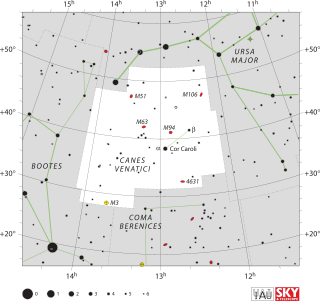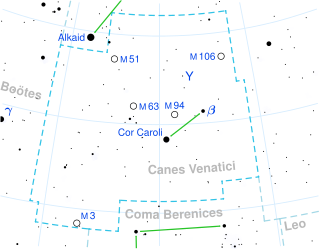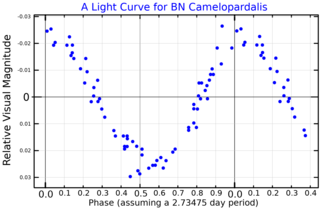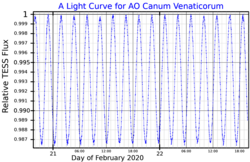
Cor Caroli is a binary star designated Alpha Canum Venaticorum or α Canum Venaticorum. The International Astronomical Union uses the name "Cor Caroli" specifically for the brighter star of the binary. Alpha Canum Venaticorum is the brightest point of light in the northern constellation of Canes Venatici.

Chi Serpentis is a solitary star in the Serpens Caput section of the equatorial constellation Serpens. Based upon an annual parallax shift of 14.84 mas as seen from Earth, it is located around 222 light years from the Sun. The star is bright enough to be faintly visible to the naked eye, having an apparent visual magnitude of +5.30.

Delta Scuti, Latinized from δ Scuti, is a variable star in the southern constellation Scutum. With an apparent visual magnitude that fluctuates around 4.72, it is the fifth-brightest star in this small and otherwise undistinguished constellation. Analysis of the parallax measurements place this star at a distance of about 199 light-years from Earth. It is drifting closer with a radial velocity of −45 km/s.

63 Andromedae is an Alpha2 Canum Venaticorum variable star in the constellation Andromeda. Its variable star designation is PZ Andromedae. With an apparent magnitude of about 5.6, it is bright enough to be seen by naked eye. Based upon an annual parallax shift of 8.53 mas, it is located 382 light years away.

21 Aquilae is a solitary variable star in the equatorial constellation of Aquila. It has the variable star designation V1288 Aql; 21 Aquilae is its Flamsteed designation. This object is visible to the naked eye as a dim, blue-white hued star with a baseline apparent visual magnitude of about 5.1. The star is located at a distance of around 680 light-years from Earth, give or take a 20 light-year margin of error. It is moving closer to the Earth with a heliocentric radial velocity of –5 km/s.

Beta Canum Venaticorum, also named Chara, is a G-type main-sequence star in the northern constellation of Canes Venatici. At an apparent visual magnitude of 4.25, it is the second-brightest star in the constellation. Based upon an annual parallax shift of 118 mas, this star is 27.6 light-years distant from the Sun.
21 Canum Venaticorum is a single variable star in the northern constellation of Canes Venatici, located 277 light years away from the Sun. This object has the variable star designation BK Canum Venaticorum; 21 Canum Venaticorum is the Flamsteed designation. It is visible to the naked eye as a faint white-hued star with a baseline apparent visual magnitude of +5.14.

4 Canum Venaticorum is a binary star system in the northern constellation of Canes Venatici, located around 425 light years away. It has the variable star designation AI Canum Venaticorum; 4 Canum Venaticorum is its Flamsteed designation. Its brightness varies from magnitude +5.89 to +6.15 with a period of 2.8 hours, which places it around the lower limit of visibility to the naked eye. This was found to be a binary by Schmid et al. in 2014, based on periodic, non-sinusoidal changes in its radial velocity. It is a single-lined spectroscopic binary with an orbital period of 124.4 days and an eccentricity of 0.31.

KK Andromedae, also known as HD 9531, is a variable star in the northern constellation of Andromeda. It has an apparent visual magnitude of 5.90, which places it near the lower limit of visibility to the naked eye even under good viewing conditions. An Alpha2 Canum Venaticorum variable, it varies in brightness by 0.012 magnitude every 0.66 days. Based upon an annual parallax shift of 7.5 mas as seen from Earth, it is located around 437 light years from the Sun. At that distance, the brightness of the star is diminished by an extinction of 0.26 magnitude due to interstellar dust.
VZ Arietis is single, white-hued star in the northern zodiac constellation of Aries. Varying between magnitudes 5.82 and 5.89, the star can be seen with the naked eye in dark, unpolluted areas. Based upon an annual parallax shift of 5.8 mas, it is located 560 light years from the Sun. It is moving further away with a heliocentric radial velocity of +14 km/s. The star was formerly known as 16 Trianguli, but as the star is no longer in the constellation Triangulum, this designation has fallen out of use.

IQ Aurigae is a single, variable star in the northern constellation of Auriga. It is visible to the naked eye as a dim, white-hued star with an apparent visual magnitude that fluctuates around 5.38. The star is located at a distance of about 460 light-years from the Sun based on parallax and is drifting further away with a radial velocity of +28.6 km/s.

V352 Aurigae is a variable star in the northern constellation of Auriga. It dimly visible to the naked eye with an apparent visual magnitude that ranges from 6.13 down to 6.18. According to the Bortle scale, it is faintly visible to the naked eye from dark rural skies. The star is located at a distance of approximately 970 light years from the Sun based on parallax, but is drifting closer with a radial velocity of −7 km/s.

BN Camelopardalis is a suspected astrometric binary in the northern circumpolar constellation of Camelopardalis. It appears as a variable star that is visible to the naked eye as a dim, white-hued point of light with an apparent visual magnitude that fluctuates around 5.49. The system is located at a distance of around 310 light years from the Sun based on parallax, and is drifting further away with a radial velocity of +9 km/s.

64 Eridani is a single, yellow-white hued star in the constellation Eridanus having variable star designation S Eridani. It is faintly visible to the naked eye with an apparent visual magnitude of 4.77. The annual parallax shift is measured at 12.01 mas, which equates to a distance of about 272 light years. In addition to its proper motion, it is moving closer to the Sun with a radial velocity of around −9 km/s.
4 Cygni is a binary star system in the northern constellation of Cygnus. It is a faintly visible to the naked eye with an apparent visual magnitude of 5.17. The distance to 4 Cygni, as determined from its annual parallax shift of 5.8 mas, is about 560 light years.

BF Antliae, or HD 86301, is a variable star in the southern constellation of Antlia. It has a baseline apparent visual magnitude of 6.32, which indicates it lies near the lower limit of visibility for faint stars. The distance to BF Ant, as determined from its annual parallax shift of 6.9 mas, is 473 light years. It is moving further away with a heliocentric radial velocity of +18 km/s.

RS Canum Venaticorum is a binary star system in the northern constellation of Canes Venatici. It serves as the prototype to the class of RS Canum Venaticorum variables. The peak apparent visual magnitude of this system is below the level needed to observe it with the naked eye. It is located at a distance of approximately 443 light years from the Sun based on parallax, but is drifting closer with a net radial velocity of −14 km/s. Olin J. Eggen (1991) included this system as a member of the IC 2391 supercluster, but it was later excluded.

SZ Piscium is a suspected triple star system in the equatorial constellation of Pisces. The inner pair form a double-lined spectroscopic binary with an orbital period of 3.966 days. It is a detached Algol-type eclipsing binary of the RS Canum Venaticorum class with a subgiant component. The system is too faint to be readily visible to the naked eye with a combined apparent visual magnitude of 7.18. It is located at a distance of approximately 306 light years based on parallax measurements.

HD 125248 is a binary star system in the equatorial constellation of Virgo. It has the variable star designation CS Virginis, while HD 125248 is the designation from the Henry Draper Catalogue. This system is dimly visible to the naked eye as a point of light with an apparent visual magnitude that ranges from 5.84 down to 5.95. It is located at a distance of approximately 280 light years from the Sun based on parallax measurements, but is drifting closer with a heliocentric radial velocity of −8 km/s.

WZ Columbae, also known as HD 38170, is a solitary, bluish-white hued star located in the southern constellation Columba, the dove. It has an apparent magnitude of 5.28, allowing it to be faintly visible to the naked eye. Based on parallax measurements from the Gaia spacecraft, the object is about 365 light years distant. It appears to be receding from the Solar System, having a heliocentric radial velocity of 36.3 km/s.

















